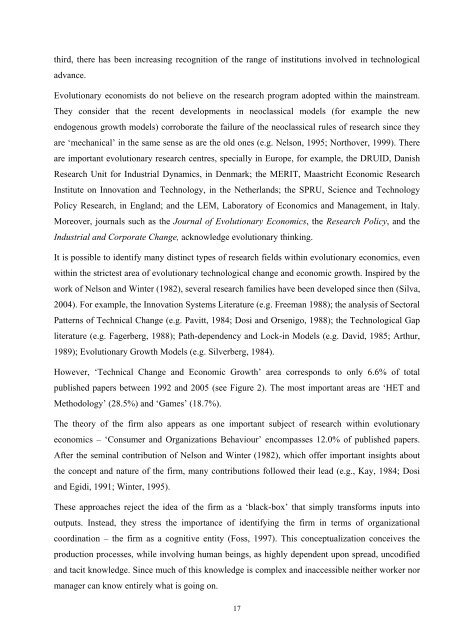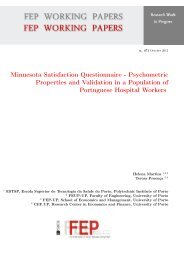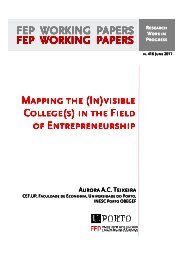Capa wps - FEP - Working Papers - Universidade do Porto
Capa wps - FEP - Working Papers - Universidade do Porto
Capa wps - FEP - Working Papers - Universidade do Porto
You also want an ePaper? Increase the reach of your titles
YUMPU automatically turns print PDFs into web optimized ePapers that Google loves.
third, there has been increasing recognition of the range of institutions involved in technological<br />
advance.<br />
Evolutionary economists <strong>do</strong> not believe on the research program a<strong>do</strong>pted within the mainstream.<br />
They consider that the recent developments in neoclassical models (for example the new<br />
en<strong>do</strong>genous growth models) corroborate the failure of the neoclassical rules of research since they<br />
are ‘mechanical’ in the same sense as are the old ones (e.g. Nelson, 1995; Northover, 1999). There<br />
are important evolutionary research centres, specially in Europe, for example, the DRUID, Danish<br />
Research Unit for Industrial Dynamics, in Denmark; the MERIT, Maastricht Economic Research<br />
Institute on Innovation and Technology, in the Netherlands; the SPRU, Science and Technology<br />
Policy Research, in England; and the LEM, Laboratory of Economics and Management, in Italy.<br />
Moreover, journals such as the Journal of Evolutionary Economics, the Research Policy, and the<br />
Industrial and Corporate Change, acknowledge evolutionary thinking.<br />
It is possible to identify many distinct types of research fields within evolutionary economics, even<br />
within the strictest area of evolutionary technological change and economic growth. Inspired by the<br />
work of Nelson and Winter (1982), several research families have been developed since then (Silva,<br />
2004). For example, the Innovation Systems Literature (e.g. Freeman 1988); the analysis of Sectoral<br />
Patterns of Technical Change (e.g. Pavitt, 1984; Dosi and Orsenigo, 1988); the Technological Gap<br />
literature (e.g. Fagerberg, 1988); Path-dependency and Lock-in Models (e.g. David, 1985; Arthur,<br />
1989); Evolutionary Growth Models (e.g. Silverberg, 1984).<br />
However, ‘Technical Change and Economic Growth’ area corresponds to only 6.6% of total<br />
published papers between 1992 and 2005 (see Figure 2). The most important areas are ‘HET and<br />
Metho<strong>do</strong>logy’ (28.5%) and ‘Games’ (18.7%).<br />
The theory of the firm also appears as one important subject of research within evolutionary<br />
economics – ‘Consumer and Organizations Behaviour’ encompasses 12.0% of published papers.<br />
After the seminal contribution of Nelson and Winter (1982), which offer important insights about<br />
the concept and nature of the firm, many contributions followed their lead (e.g., Kay, 1984; Dosi<br />
and Egidi, 1991; Winter, 1995).<br />
These approaches reject the idea of the firm as a ‘black-box’ that simply transforms inputs into<br />
outputs. Instead, they stress the importance of identifying the firm in terms of organizational<br />
coordination – the firm as a cognitive entity (Foss, 1997). This conceptualization conceives the<br />
production processes, while involving human beings, as highly dependent upon spread, uncodified<br />
and tacit knowledge. Since much of this knowledge is complex and inaccessible neither worker nor<br />
manager can know entirely what is going on.<br />
17











